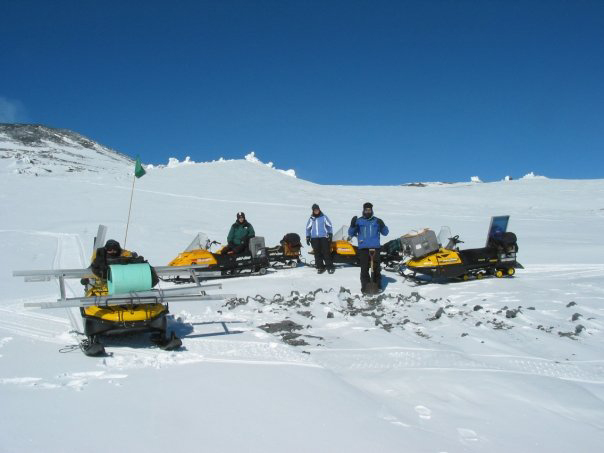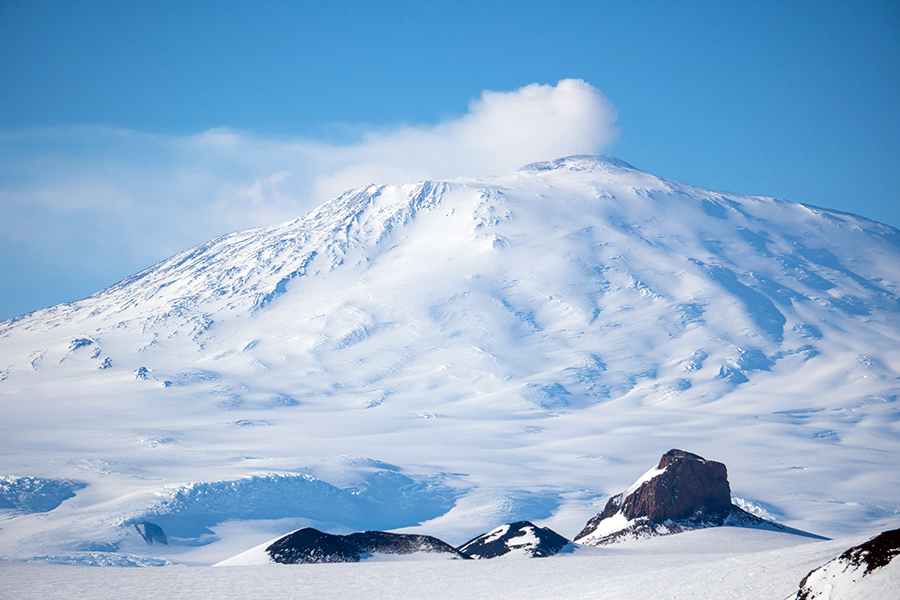Antarctic ice shivers from distant earthquakesIce coating the flanks of Mt. Erebus vibrates following some of Earth's biggest tremorsPosted October 07, 2021
Antarctica is the most remote continent on Earth, but new research shows it is still connected to what happens in the rest of the world. A new study finds large earthquakes can cause ice on the slopes of Antarctica's Mt. Erebus to quiver and vibrate, even when the quake happens thousands of miles away. These icequakes, as they're called, aren't large enough to cause any harm but humans can hear them when they cause the ice to crack and pop. "Large earthquakes that are a thousand miles away from Mt. Erebus can affect the seismic activity here," said Chenyu Li, a geophysicist at the Georgia Institute of Technology and lead author of the new study. "The higher the magnitude, the further away it can be felt." The research is helping scientists better understand the hazards associated with earthquakes and learn how quakes can trigger other geophysical phenomena around the world. Icequakes aren't a hazard at Erebus, but they can be dangerous for communities near mountains prone to avalanches, according to the researchers. "There are many other places where snow and ice are on the cusp of failure, and if you get some kind of triggering like this, you can generate avalanches," said Julien Chaput, a seismologist at the University of Texas-El Paso and co-author of the new study. "It's interesting studying the physical parameters that allow these sorts of triggering to happen." Traveling wavesWhen an earthquake happens, waves of energy called seismic waves travel through Earth's various layers. These waves cause the shaking that destroys buildings and endangers human lives. Seismic waves travel through all of Earth's layers (even its core) and can trigger smaller tremors far away from the original quake. 
Photo Credit: Hunter Knox
Scientists install seismic equipment on the flanks of Mt. Erebus during the 2007-2008 austral summer. That equipment picked up vibrations from distant quakes that were analyzed in the new study
Icequakes are just like earthquakes, except ice cracks and vibrates instead of the ground. They're triggered by a variety of different things including the melting or calving of a glacier; an ice sheet sliding over bedrock; earthquakes or volcanic eruptions; or even ocean water slapping against an ice shelf. Icequakes are common at Mt. Erebus, the southernmost active volcano, thanks to its frequent eruptions. Eruptions at Erebus are usually small but happen so often they trigger a quarter-million icequakes every year, according to Chaput. That's nearly 700 icequakes every day. Researchers camping near the summit of Erebus often hear the peal of icequakes on the volcano's slopes. "It's just an enormous amount; it happens constantly," Chaput said. "When you're up on Erebus and you're sleeping on the ice, you can hear them – these high-frequency pings." Scientists know seismic waves can travel far and that earthquakes can trigger icequakes, but they weren't sure if distant earthquakes could trigger any kind of shaking of the ice or ground at Erebus. In the new study, Li and her colleagues looked for evidence of any seismic activity at Erebus that could have been triggered remotely by a distant earthquake. They studied seismic data from the Mt. Erebus Volcano Observatory, a network of sensors around the volcano designed to keep tabs on its activity. The researchers analyzed seismic waves recorded by the Observatory's sensors from 2000 to 2017 and compared the data with a catalog of 43 large earthquakes occurring all over the world during that time. They looked for any seismic signals at Erebus that were recorded a day before and after a large earthquake and then analyzed whether the signals were caused by that particular earthquake. Shaking causes shakingThe results show two major earthquakes caused icequakes at Erebus: a magnitude 8.8 quake that struck Chile on February 27, 2010, and a magnitude 8.6 quake in the Indian Ocean near Indonesia on April 11, 2012. The researchers saw five other large quakes that may have induced shaking at Erebus, but they need to do a more detailed analysis of the data to say for sure. The results suggest it takes a large earthquake to trigger icequakes on the southernmost continent. Additionally, the further away a quake is, the larger it must be for it to shake the slopes of Erebus. "A magnitude 7 event in Chile can be felt in Antarctica, and a magnitude 9 event in Japan or North America," Li said. "But a smaller event at magnitude 6 in California cannot be felt at Erebus." The researchers also found earthquakes are more likely to trigger icequakes at Erebus during the austral summer months, possibly because of warmer temperatures making the ice moving more easily. But icequakes don't pose a hazard at Erebus because of the volcano's unique location. The weather is so cold and dry at Erebus that there's not enough snowfall to trigger a dangerous avalanche. "The only snow that's very weak is the few centimeters on top," Chaput said. "The rest of it actually feels like Styrofoam. So avalanches on Erebus are sort of inconceivable." But avalanches are a serious hazard in other mountain regions of the world, and the new study could help researchers understand what triggers them. "Even if it doesn't apply directly to Erebus, I think these sorts of studies can be useful in understanding at what point we expect failure to potentially happen in this medium if it's forced the right way," Chaput said. "It can have broad ranging applications." This research is supported by the National Science Foundation, which manages the U.S. Antarctic Program. NSF-funded research in this story: Zhigang Peng, Georgia Institute of Technology, Award No. 1543399; Jacob Walter, University of Oklahoma, Award No. 1745135; and Robert Woodward, Incorporated Research Institutions for Seismology, Award No. 1851048. |
"News about the USAP, the Ice, and the People"



For USAP Participants |
For The Public |
For Researchers and EducatorsContact UsU.S. National Science FoundationOffice of Polar Programs Geosciences Directorate 2415 Eisenhower Avenue, Suite W7100 Alexandria, VA 22314 Sign up for the NSF Office of Polar Programs newsletter and events. Feedback Form |


